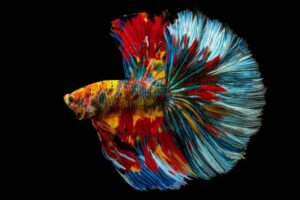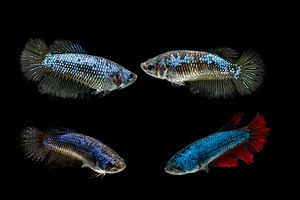Betta fish breeding is a fascinating process that has captivated hobbyists and enthusiasts for years. In this article, we delve into the intricate world of betta fish mating and reproduction. From courtship rituals to the spawning process, discover the secrets behind successful betta breeding and gain valuable insights into this mesmerizing aquatic endeavor.
About Betta Fish

Many people believe the betta fish is one of the most beautiful aquarium fish.
©Digital Art StudioTH/Shutterstock.com
Betta fish, also known as Siamese fighting fish, is a freshwater species of fish native to Thailand, Cambodia, and Vietnam. They are known for their vibrant colors and long fins and are a popular choice for home aquariums. Betta fish come in a variety of colors, ranging from bright oranges and blues to deep purples and reds. Some of the most common types of betta fish are the veil tail, crown tail, half-moon, delta, and plakat.
Betta fish are very active and need a minimum of 5 gallons of space for proper swimming and exercise. They also need plenty of plants, rocks, and other decor to hide and explore. Betta fish are carnivorous, so they should be fed a high-quality diet of pellets, bloodworms, brine shrimp, and other live and freeze-dried foods.
Betta fish are territorial and can become aggressive towards other fish or even their own reflections. They should be kept in separate tanks or with fish of similar size and temperament. Betta fish can live up to five years with proper care and can even be trained to do tricks like swimming through hoops or following a finger.
In general, betta fish are easy to care for and are a great choice for beginner aquarists. With their vibrant colors, friendly personalities, and ease of care, betta fish are sure to be a great addition to any home aquarium.
Creating the Ideal Conditions for Betta Fish

Give each betta fish a minimum of 5 gallons of water.
©SritanaN/Shutterstock.com
Betta fish are a popular and beautiful choice to add life and color to your fish tank. To ensure your betta is happy and healthy, it’s important to provide a tank that meets its specific needs. Here’s how to set up the perfect tank for your betta fish and create the ideal conditions for breeding.
Tank Requirements
The minimum tank size for one betta fish is 5 gallons, but bigger is always better. If you can, try to go for a tank larger than 10 gallons. You’ll also need to make sure the tank has a secure lid since bettas are notorious jumpers. You should house male betta fish alone or with compatible tank mates (not other betta fish). Females can be kept in groups of four or more. Using the five gallons per fish method means four females require 20 gallons of water.
Filtration
Filtration is essential for any aquarium, and bettas are no exception. A hang-on-back filter is a great choice since it’s relatively compact and easy to set up. Just make sure to choose one that’s appropriate for your tank size. Betta fish don’t like very strong water flow, so choose a gentle or adjustable filter.
Substrate
Betta fish like to have a soft substrate at the bottom of their tank. You can opt for either a sand or gravel substrate. Just make sure it’s smooth and free of sharp edges. Note that the breeding tank does not have a substrate.
Decorations
Bettas love to explore, so adding some decorations is a great way to give them an extra layer of enrichment. Try to find decorations with plenty of hiding places, like caves, tunnels, or plants.
Temperature
Bettas prefer water temperatures of around 76-80°F (25-27°C). To help maintain the temperature, you may want to invest in a submersible heater. Having nice warm water also ensures that you will be able to breed betta fish successfully.
Water Quality
Finally, it’s important to make sure you’re testing your water regularly and doing regular water changes. Keeping the water clean and free of toxins will help keep your betta happy and healthy.
Breeding Betta Tank Requirements
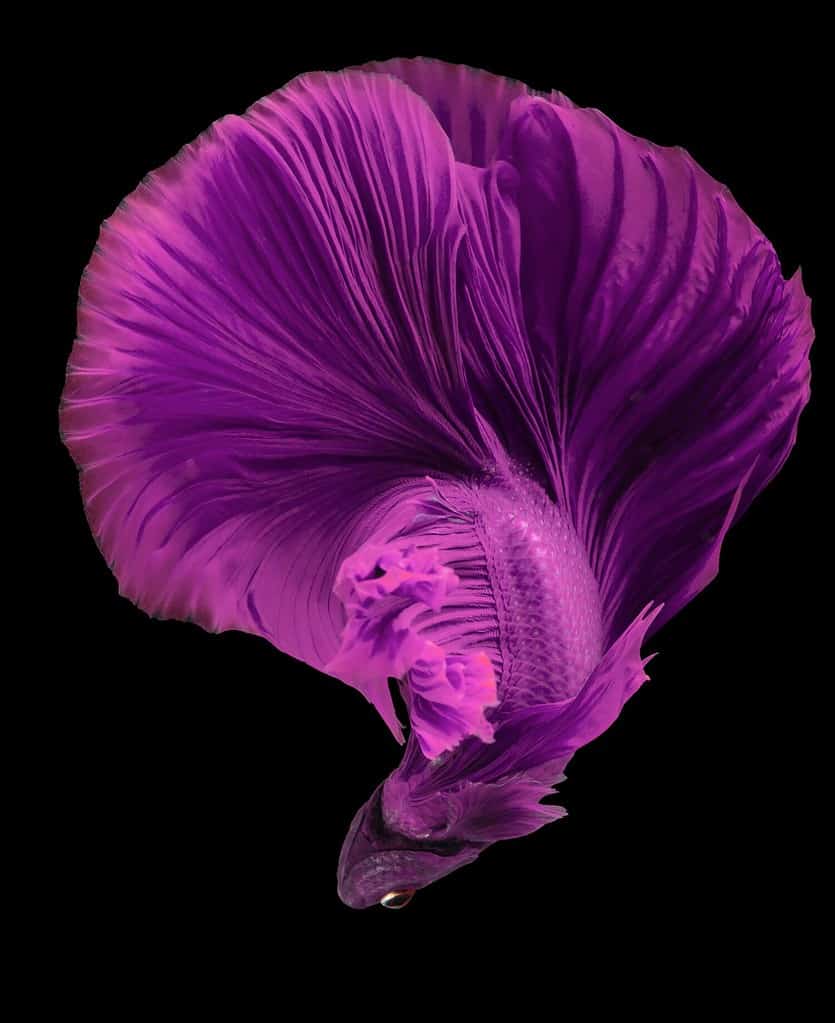
The betta fish comes in many different colors and fin types.
©Digital Art StudioTH/Shutterstock.com
When breeding bettas, the tank should be at least 10 gallons in size, with no substrate. Leafy plants can be added to provide hiding places for the fish. Additionally, you will need something at the water’s surface that the male betta can use to build a bubble nest. This could include a plant with broad leaves touching the surface, an Indian almond leaf, or a small piece of Styrofoam. The bubble nest is essential for protecting the fry, so this is an important step in betta fish breeding.
When choosing a spot for breeding betta fish, it is important to select a location that is quiet and not overly bright. The tank should be relatively shallow, with only five inches of water, and kept at a steady temperature of 78 degrees Fahrenheit. A filter should be used to keep the breeding tank clean, but be sure to pick one that has a gentle flow and a fine intake so it won’t suck up any fry. Filtration that is too strong will damage the bubble nest.
How to Choose a Pair of Betta Fish to Breed
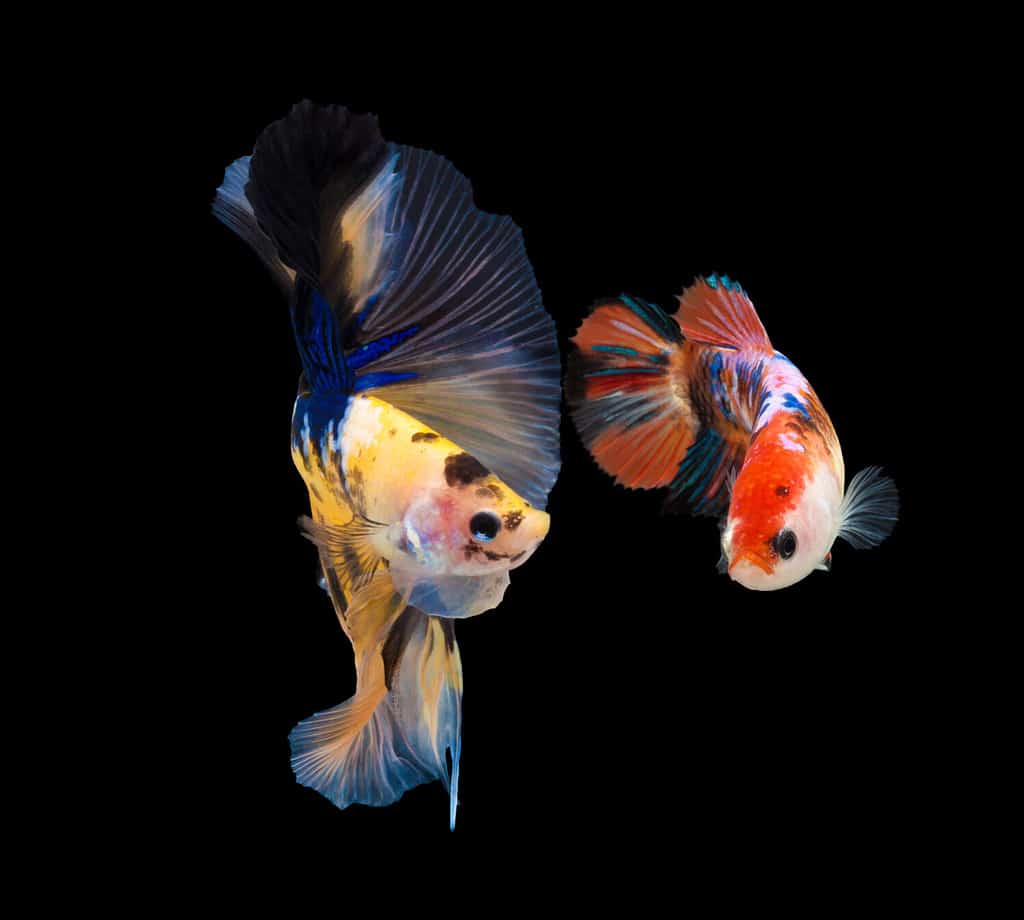
Choose healthy and vibrant bettas with characteristics that you want to breed.
©panpilai paipa/Shutterstock.com
When it comes to breeding betta fish, it’s important to make sure you choose a healthy pair. This means looking out for any signs of sickness or deformities. You’ll also want to make sure both fish are between 4 and 12 months old, as they will be more mature and ready to breed. If they are older than 1.5 years of age, breeding is often unsuccessful.
When selecting a pair of betta fish, it’s important to consider the features that you wish to breed. This could include size, water temperature, color, or type of tail. Take into consideration the desired features that you want to see in the offspring betta fish.
Once you’ve narrowed down your selection, it’s important to take a closer look at the health of the fish. Look for any signs of disease or deformities. Check the eyes, fins, and tail for any abnormalities. Make sure both fish look healthy and active.
You’ll also want to examine the betta fish’s behavior. Are they aggressive toward each other? Do they both appear active and curious? These are important questions to ask when selecting a pair of betta fish.
Finally, make sure to research the betta fish’s history. Find out where the fish came from and how they were raised. This will provide insight into the overall health of the fish.
Creating Ideal Breeding Conditions
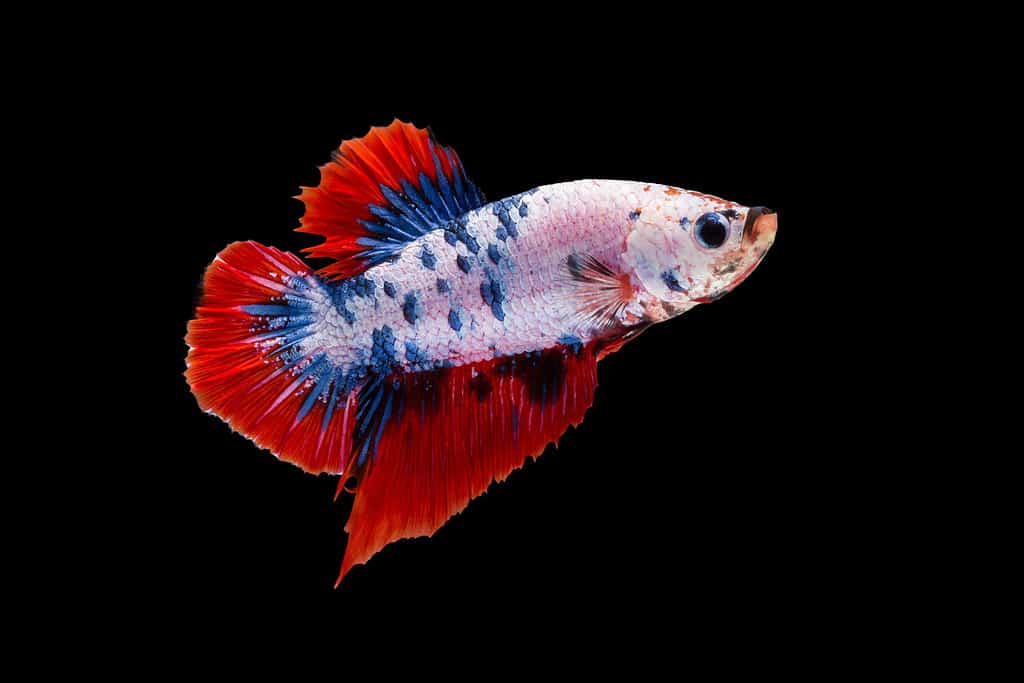
Completely cycle the tank before breeding to ensure it is chemical-free.
©pritsana/Shutterstock.com
To create ideal breeding conditions for betta fish, it’s important to fully cycle the tank to deter chemical spikes. You’ll also want to create humid air at the top of the tank using plastic, and make sure to add a filter with a gentle flow and a fine intake. An inexpensive piece of plastic wrap stretched over the top of the tank will increase the humidity, making the conditions ideal.
Choose a location that is quiet and not overly bright, and keep the water temperature at 78 degrees Fahrenheit. Finally, make sure to test the water regularly and do regular water changes to keep the water clean and free of toxins.
Conditioning Betta Fish for Breeding

Keeping the tank a nice warm 78 degrees will help betta eggs survive.
©rhodyway/Shutterstock.com
Breeding betta fish can be a fun and rewarding activity. To ensure the health and well-being of your fish, it’s important to condition them properly before breeding. Here are a few tips to help you get your fish ready.
First, you should plan to give your fish at least two weeks to condition. During this time, you should aim to provide them with a nutritious diet that is high in protein. You can feed them a variety of foods such as brine shrimp, bloodworms, and other high-protein live foods. Make sure to feed them four times per day in small amounts so as not to overfeed them.
You should also make sure that the water parameters are suitable for breeding. Keep the temperature between 78-82°F and the pH between 6.5-7.5. Do regular water changes to ensure that the water remains clean and free of toxins.
In addition to a healthy diet and suitable water conditions, you should also provide your fish with plenty of hiding places and decorations. This will help them feel comfortable and secure. You can use driftwood, rocks, and live aquatic plants to create a suitable breeding environment.
Adding the Female to the Tank

Keep a divider between the male and female fish for a few days while they get acquainted.
©panpilai paipa/Shutterstock.com
When introducing a female to a breeding tank, it is important to keep her separate from the male until they are ready to mate. This can be done by using a divider or separator to keep them apart. This will give them time to get acquainted with each other without risking any physical contact. A tall glass tube that is open at both ends also works for this purpose.
Once the female is in the tank, the divider can be left in place for a few days to a week. This will give the fish plenty of time to get used to each other’s presence. During this time, the female can be observed to see if she is showing any signs of stress. If she seems to be doing well, the divider can be removed.
It is important to keep a close eye on the fish while the divider is being removed. If the female shows any signs of aggression, the divider should be put back in place until she is more comfortable. If the fish are both calm and the female does not seem to be too stressed, the divider can be left off completely.
Once the divider is removed, the fish will have the opportunity to get to know each other better. They may swim around each other, but it is important to watch to make sure they are not fighting. If they seem to be getting along, they can be left together to get used to each other.
Betta Fish Courting

Betta fish mating is a fascinating process that you can facillitate at home.
©panpilai paipa/Shutterstock.com
Once the male and female betta fish have been introduced to the breeding tank, the male will start to show signs of readiness for mating. He will flare his fins, dance around the female, and his colors will become more vibrant. These behaviors are all part of the courting process.
When a female betta is ready to breed, her colors will become more vivid, and there will be vertical dark stripes on her body. Additionally, a small white tube, known as the ovipositor, can be seen behind her ventral fin. This is where the eggs will come from. These changes indicate that she is ready to mate.
The Betta Fish Bubble Nest
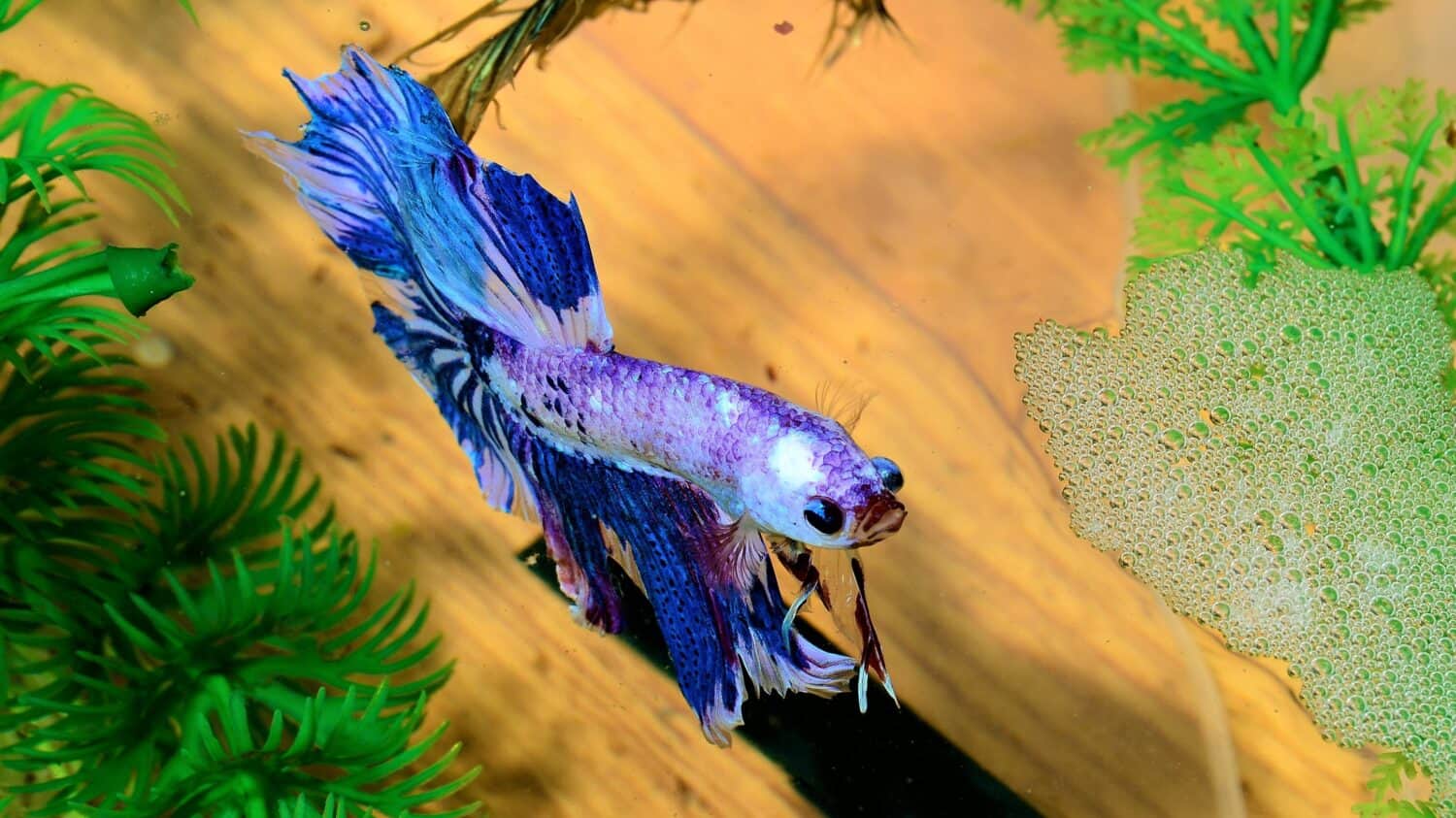
The male betta fish creates the bubble nest and takes care of the eggs and fry.
©JuanCarlosPalauDiaz/Shutterstock.com
One of the most remarkable behaviors of betta fish breeding is the creation of a bubble nest.
The bubble nest is created by the male Betta fish in preparation for breeding. He will take his saliva and blow it into the water to form a bubble nest on the surface. This nest is a collection of bubbles that are held together by saliva. It is thought that the bubbles help the male to demonstrate his strength to the female, as only the strongest males will be able to form the biggest and most impressive nests.
The male will work very hard to create the bubble nest and will often take days to complete. He will then spend a lot of time defending it and will try to entice the female to join him under the nest. If she is ready to breed, she will make a careful inspection of the bubble nest. Then, the male and female will embrace, and the female will lay her eggs in the nest. The male will then fertilize the eggs and guard them until they hatch.
Once the eggs have hatched, the adult Betta fish should be removed from the tank, as the fry will be at risk of being eaten. The male Betta will then make another bubble nest for the next batch of eggs. This behavior is one of the most endearing traits of these fish, and it is something that many people enjoy watching when keeping these fish in their aquariums.
Betta Fish Mating
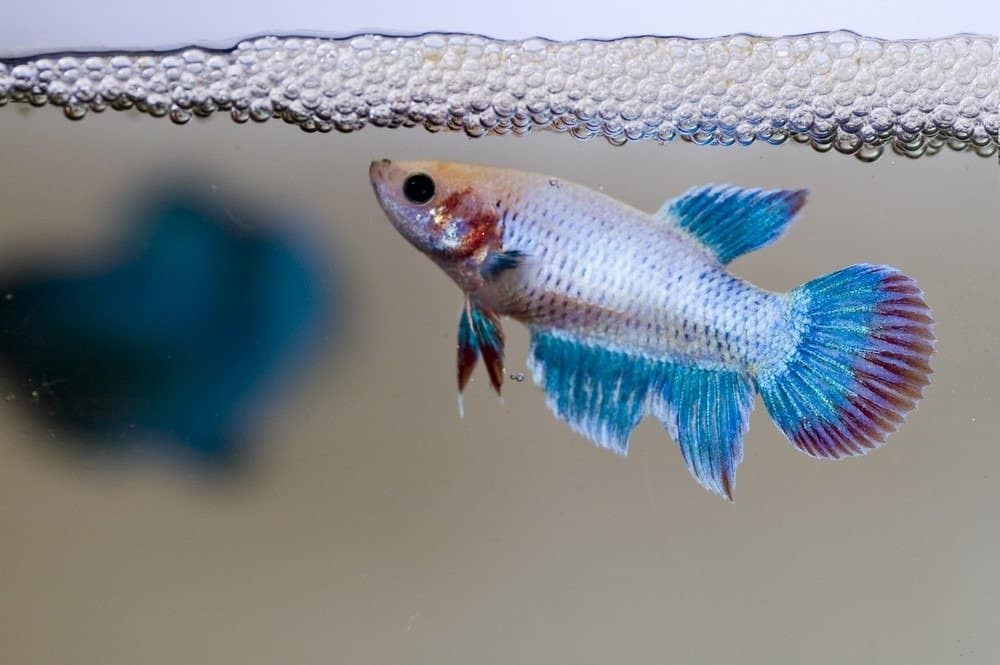
Female fighting fish guard their newly laid eggs amongst the bubble nest.
©mnoor/Shutterstock.com
It usually takes between 12 to 24 hours for the male betta fish to make a bubble nest. When the nest is ready, the female betta fish is introduced to the male. If she likes the nest, she will stay and breed with him. Otherwise, she will either leave or destroy it. If the female does not accept the nest again, it is likely that the two bettas are not compatible for breeding.
If the female betta fish is near the nesting area, it is a sign that she approves of it. The male will then swim up to her and start to move around her, as well as chase her around the tank. It is important to watch carefully while this is happening to make sure that the female does not get hurt. The male and female will move close to each other, flaring their fins at one another intermittently. This behavior of chasing and swimming together can last for up to three hours. It is best to stay away from the pair during this time, including not feeding them.
The male and female Betta fish will lock their fins multiple times until all the eggs have been released. During this process, the female may appear unwell or listless, but this is normal. As the eggs are released, the male will collect them and take them to its bubble nest.
When to Remove the Female
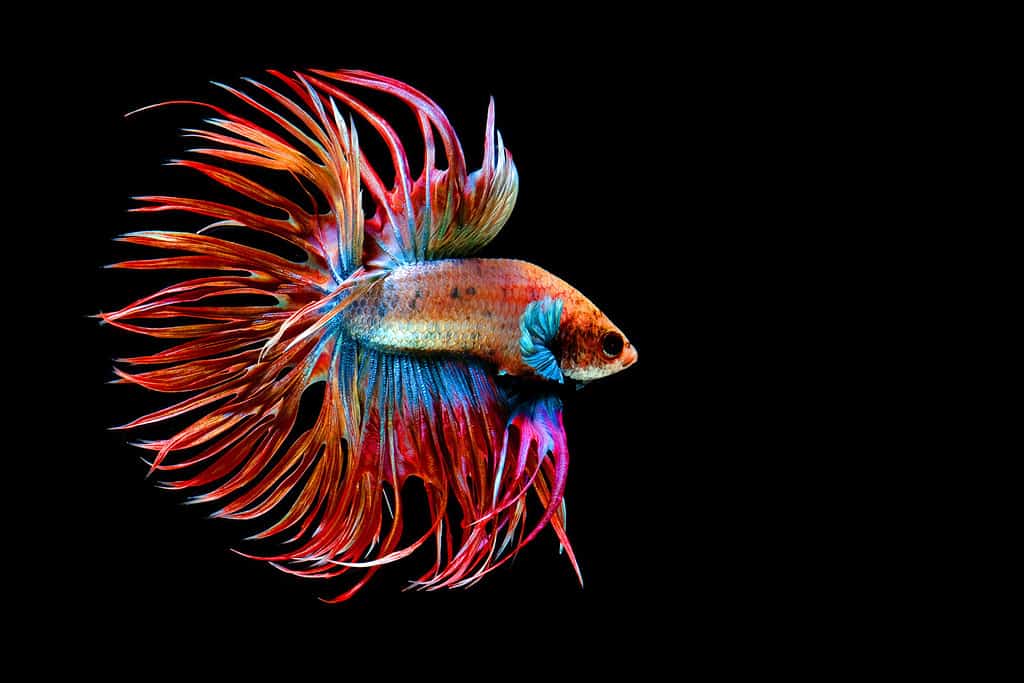
You should remove female betta fish from the nest so that they do not eat the eggs.
©Vilasack Southisane/Shutterstock.com
The act of betta fish mating and reproducing can be quite fast, taking only a short time, or it might take several hours. After the male and female stop embracing, it is best to take the female out of the tank, as she may eat the eggs she has just produced. The male will then become territorial and potentially attack the female.
Egg Hatching
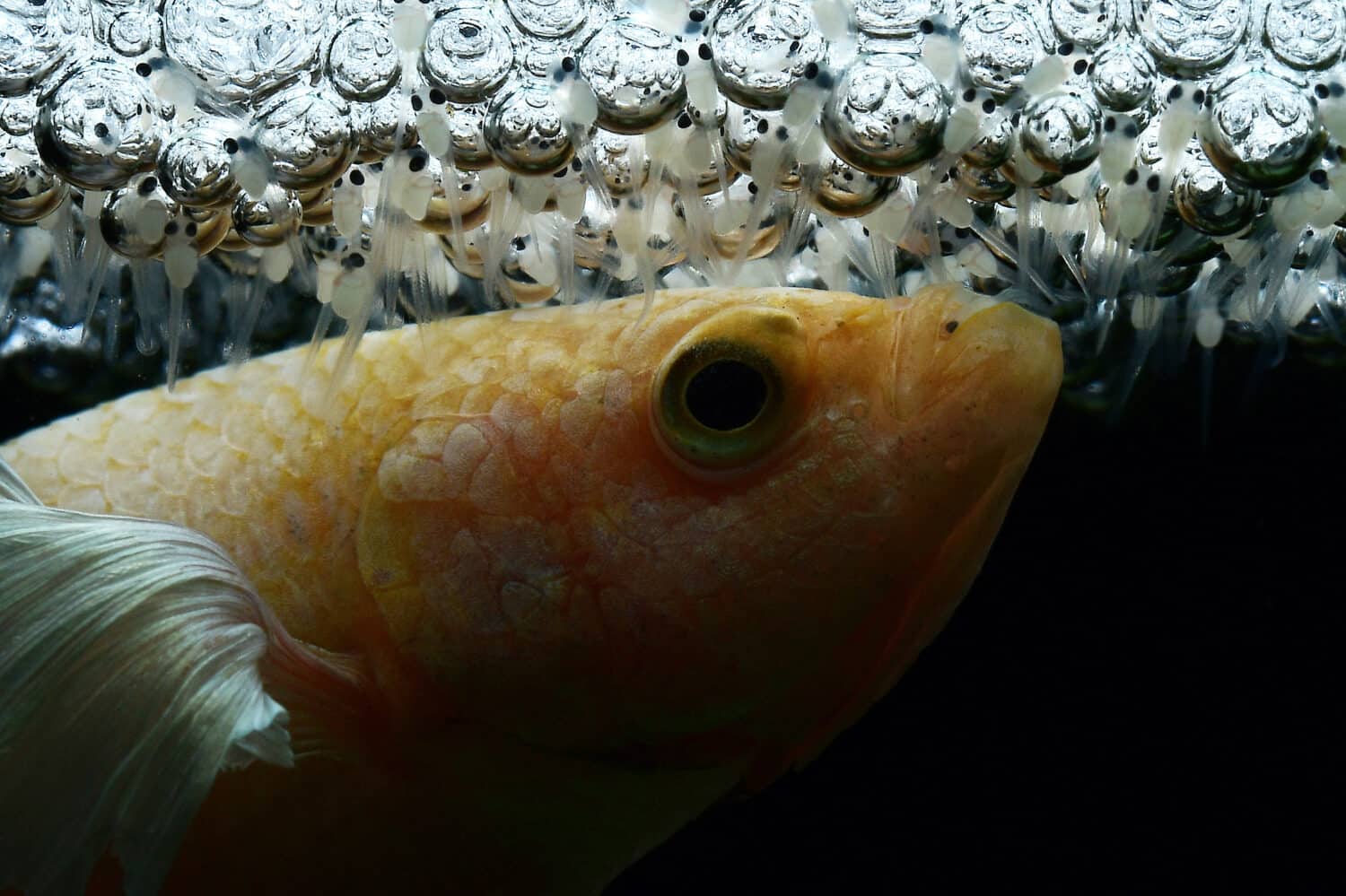
The father betta fish takes care of the eggs, even consuming the unfertilized eggs to clean the tank.
©PRAPAPORN SONRACH/Shutterstock.com
Following the laying of the eggs, the male betta will be occupied for a few days maintaining the bubble nest and bringing any eggs that sink to the bottom back up. It is not unusual to observe him eating some of the eggs, yet this is not an act of hostility but rather a way to get rid of any non-fertilized eggs.
In two or three days, the fry, or baby bettas, will come out of their eggs and be released from the nest. At this point, they are not able to swim and require additional time to grow. The male betta will gather them and move them back into the nest.
Fry Care
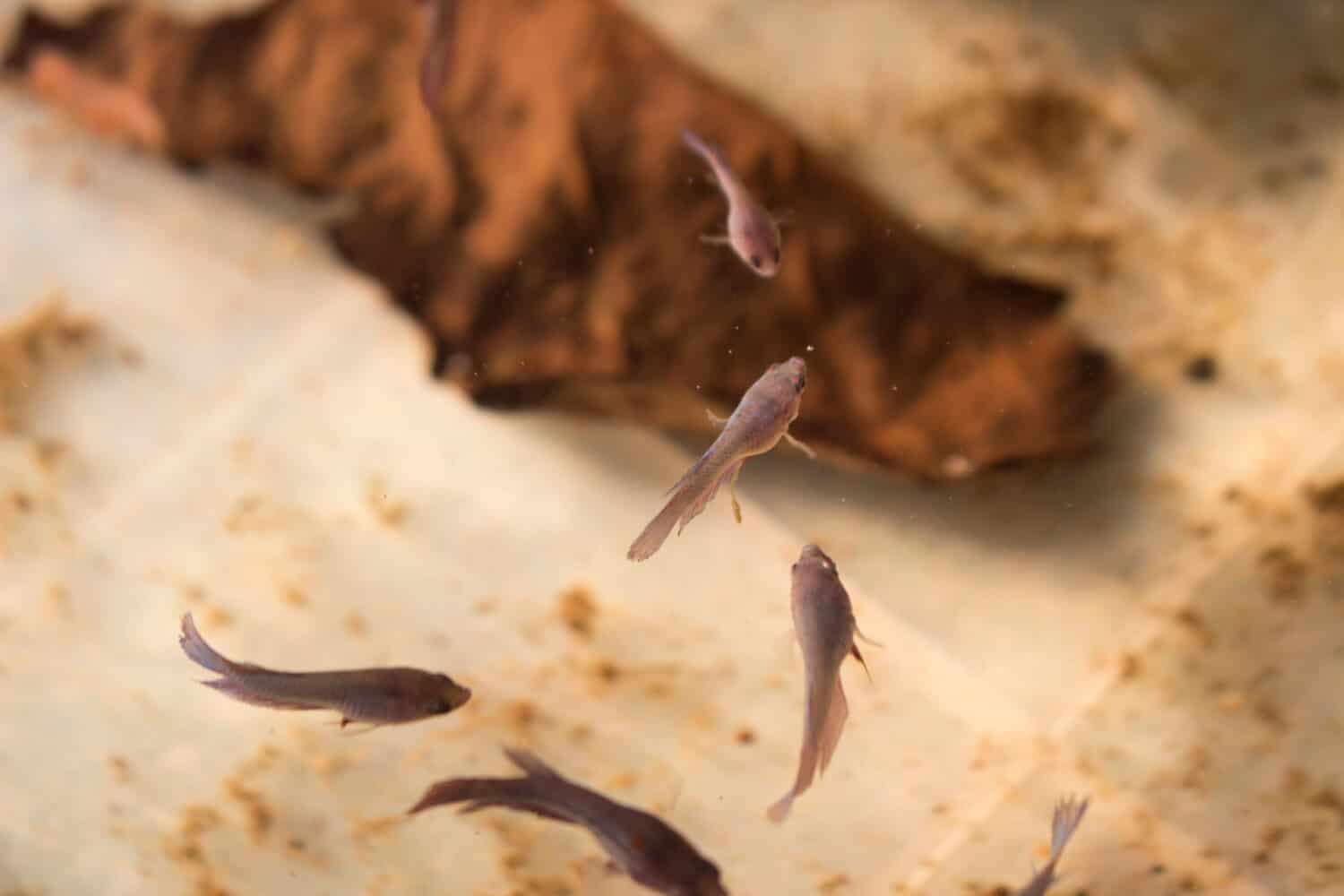
Once the betta fry can swim on their own, you can start feeding them.
©airdone/Shutterstock.com
Once the betta fry starts swimming by themselves, the male should be put in his own aquarium. Make sure to feed them a nutritious diet such as vinegar eels, mini-worms, or infusoria. It’s important to not overfeed them so the tank remains clean. As they grow, you can give them larger foods like baby brine shrimp.
After approximately two months, colors will start appearing on the fish. At this point, it’s best to place them in their own tanks or jars so they don’t become territorial. If you decide to keep them jarred, make sure they have somewhere to go, as they shouldn’t stay in jars for long periods of time.
The photo featured at the top of this post is © ErwinGucci/Shutterstock.com
Thank you for reading! Have some feedback for us? Contact the AZ Animals editorial team.




